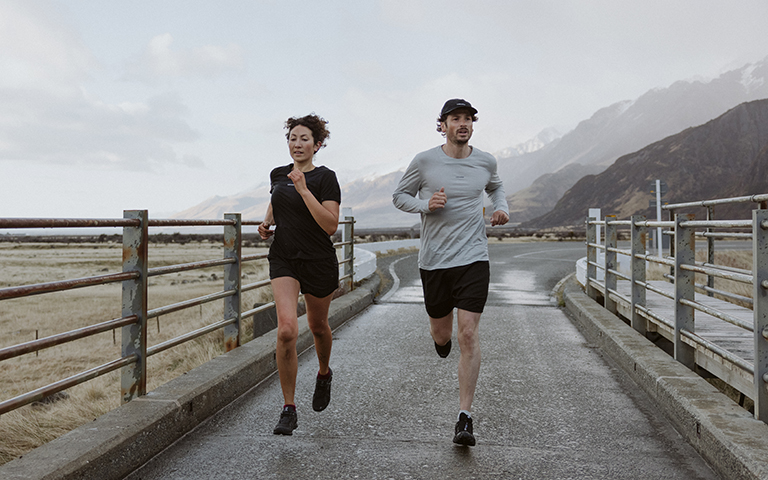How to layer for a summer hike
06 July 2023
Protecting a hiker from the sun, keeping them warm at a summit or ensuring they stay dry if the weather turns. These are just a few benefits of layering up for summer hikes. Having the right clothes will help walkers stay safe and look good while out on their adventure.
Why choosing the right hiking layers is important
Wearing and packing the right hiking layers is important to help walkers stay comfortable as they move for several hours at a time. As such, before heading out, it’s key that hikers check the weather forecast and conditions on the trail or route they’re taking.
For example, on mountainous walks, take insulated and weather-resistant layers. This will help you stay dry and warm as the temperature drops and as wind or rain pick up at higher elevations.
What to wear on a hike in summer
The exact layers you wear for your summer hike will entirely depend on how the weather conditions look on the trail you’re taking. Having a selection of clothes in your outdoor wardrobe means you’ll always have the right layers for any route.
Breathable bases
These are a must-have for any walking wardrobe. As the layer closest to your skin, the base fabrics you choose need to be breathable and soft. This will keep you comfortable and dry as you move. A merino wool base layer is ideal for this, as the fibres naturally have all these properties.
Depending on the temperatures you walk in most often, you will want to choose base layers with the right fabric weight. For example, a heavyweight base will keep you warm in colder temperatures. While featherweight layers will protect your skin from the sun without overheating.
Choosing the right design is also key to keeping you comfortable on your walk. Consider the sleeve length and neck height of your tops and the length of your bottoms.
Hiking base layers may include:
- Short sleeved t-shirts
- Camis
- Thermal tops
- Thermal leggings or shorts
Short and long layers
Having a variety of lengths available ensures your skin stays protected, dry and comfortable in any conditions. Depending on the type of walk you’re heading out on, you might wear these as your base layers or keep them in your backpack just in case you need to change.
Insulated mid layers
Wind and rain can all appear unexpectedly, even on summer walks. Plus, if you’re heading up a mountain or to higher elevations, it’s likely to get windier and cooler as you ascend. Having insulated or thick mid-layers in your backpack will stop you from getting cold as you admire the view or if you’re still exploring as the sun goes down.
Weatherproof outers
Choosing a protective outer shell will stop any rain or wind from getting to your skin and making you wet or cold. An insulated vest will keep your core warm without causing you to overheat when the sun comes out. Alternatively, a weatherproof jacket with a hood and long sleeves will protect you if the weather takes an unexpected turn.
Comfortable socks
Keeping your feet dry and at the right temperature is essential to avoid any blisters or soreness. Choosing socks made from breathable fabrics will stop your feet from rubbing in hot weather. Get pairs with added support and durability around the toes, soles, heels and ankles for extra comfort. Odour-resistant materials, like merino, will also help your socks last for longer.
Hat and gloves
Even on summer hikes, having the right headwear and a pair of gloves to hand is essential. This is because people lose heat quickly from their extremities. So it's important to keep these protected to stay at the right temperature.
Hat and headwear will stop your head from getting too hot and protect your eyes, even under direct sunlight. This will help you avoid overheating, dehydration or sunstroke.
Having some gloves handy is also recommended in case the weather turns colder. Plus, they’ll keep your hands protected if you have to scramble across rocks for long periods.
How to layer clothes for summer hikes
Depending on the conditions you’ll be facing on your summer hike, you’ll want to pick the most appropriate layering system:
-
One layer:
This is just a base layer t-shirt or top and shorts or trousers, ideal if you’re heading on a shorter walk in sunny, dry conditions.
-
Two layers:
This will always include a base layer alongside a mid or outer layer. The second layer you choose will depend on if the weather is likely to turn cold, windy or wet.
-
Three layers:
This is the ultimate level of protection against any weather and includes a base layer, mid and outer layer.
To be ready for any conditions, follow the guidelines below and pack enough layers so you can switch to a new system if required.
Start with a base layer
Your base layer should keep you comfortable and protected as you move throughout most of the walk. Depending on the temperature and amount of wind on your summer hike, this might just be a t-shirt and shorts. Lightweight long-sleeve tops and three-quarter leggings will help protect your skin from the sun's rays.
Think about the mid and outer layers
Even if you’re at a comfortable temperature as you set off on your walk, it’s recommended that you keep some warm and dry layers in your backpack. Weatherproof jackets, an insulated vest or a spare hoodie or sweatshirt will ensure you stay comfortable in any weather. Having a spare t-shirt or set of trousers will also mean you can switch out from your base layers if you need to.
Take some spare essentials
A cap or headscarf are must-have items to keep your head protected from the sun. Taking some gloves in your backpack is also recommended in case the temperatures drop or your hike runs into the evening. Spare socks and underwear is also recommended if you’re planning a long hike or fancy a spontaneous swim.
Get prepared for your summer hike
By checking the weather and conditions of your hike, you can make sure you put on and pack the right layers before you set off. Merino wool hiking clothes are naturally breathable, moisture-wicking and insulating. Making them a great choice for any summer hiker.
More for you

Merino socks for hiking | icebreaker
26 August 2020 | Marie Knowles

The Tech Behind ZoneKnit™ | icebreaker
16 September | Jamie Patterson

Washing Merino Wool Clothes | Does Merino Shrink?
28 September 2020 | Marie Knowles
More for you








